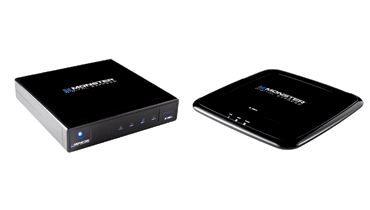Tech Trends '09: HDTV Unplugged Page 3

ULTRA-WIDEBAND
Although it's had a few false starts (Philips, for example, announced a product in 2007 that still hasn't seen the light of day), UWB also made a positive showing at CES, primarily in new wireless systems from Monster Cable and Gefen. UWB operates in the 3.1-GHz to 10.6-GHz spectrum, and so far has been limited to a maximum data rate of 480 Mbps at distances of less than 10 feet, or 110 Mbps at the end of its 30-foot range. As a result, it's best suited for in-room applications, although it doesn't require a direct line of sight, allowing components to be located in an adjacent room or closet.
A key selling point of UWB is that it's a proven technology (the FCC gave it the okay back in 2002) with greater throughput and less susceptibility to interference or fading than Wi-Fi. UWB can handle 1080p video signals, but it requires compression (such as Analog Devices' JPEG 2000 or H.264) to do so. Its backers, however, say technological enhancements - such as the use of multiple antennas in transmitters and receivers (multiple-input/multiple-output, or MIMO), which can send simultaneous data streams to pump up data rates, and "smart" (beam-forming) antennas - are helping push performance into gigabit territory. A UWB standard called WiMedia has been created by the nonprofit WiMedia Alliance to help ensure interoperability between all WiMedia-compliant devices in the home, regardless of brand.
Several companies, including Tzero, Radiospire, and Pulse-LINK, have developed UWB chip sets that are expanding the boundaries of the technology, including improvements in video quality, latency, and error resiliency caused by fluctuating channel bandwidth. Tzero's first chip set, used in Gefen's wireless UWB media extender, employs JPEG2000 video compression, but a newer version using the H.264 codec is said to deliver a maximum data rate of 480 Mbps, with full support for 1080p/60 video and 7.1-channel digital audio at a maximum range of about 60 feet. The chip sets also support CEC and include digital copy protection. Pulse-LINK, which gained attention by partnering with Westinghouse for commercial TVs with its CWave UWB technology, has a reference design that allows CWave to work both wirelessly and over coax simultaneously from the same chip set.
At CES, Monster Cable garnered attention with its Wireless Digital Express HD system ($999), which is based on a Sigma Design UWB chip set. The hybrid wireless/coax system uses an H.264-compliant decoder and Sigma's UWB Over Coax chip set to send up to 1080p video wirelessly within a room, or up to 330 feet using existing coaxial cable. The system can upscale all content to 1080p and comes with three IR emitters. Gefen's currently available Wireless for HDMI UWB Extender ($999) uses Tzero's UWB chip set to support 1080p/30 HD video with 7.1-channel digital surround sound and 2-channel analog audio.
802.11N
Working in the same 5-GHz band used by WHDI, 802.11n - a.k.a. Wi-Fi - is nothing if not ubiquitous, although it's still used more for computer-based wireless broadband networks than for streaming high-def video. Like UWB, 802.11n employs compression to send high-def video between sources, but its 100-foot-plus range makes it suitable for A/V distribution throughout the entire house. Although "draft n"-compliant products have been available for well over a year, the 802.11n standard won't be finalized until this June.
The 802.11n technology has a maximum data rate of about 150 Mbps (using MIMO, part of the 802.11n spec). Proponents argue that next-generation Wi-Fi is a proven technology capable of inexpensive high-def video delivery to all the rooms of a house. But critics worry that Wi-Fi's lower data rate, higher latency, need to support legacy devices, and greater susceptibility to bandwidth fluctuations and fading make it a poorer choice than competing technologies for sending HD video. A few TV manufacturers, including LG (the LG71) and Samsung (FP-T5894W), have offered TVs with separate Wi-Fi-enabled media modules, but so far the technology hasn't taken hold.
As things stand, 2009 could be the year that wireless HD technologies jump from promise to reality, although consumers could well be overwhelmed by the multitude of choices and technologies. In the near term, it's likely that several technologies will coexist in the market to be used for specific applications.
Now if we could just do something about those power cords.
- Log in or register to post comments



































































